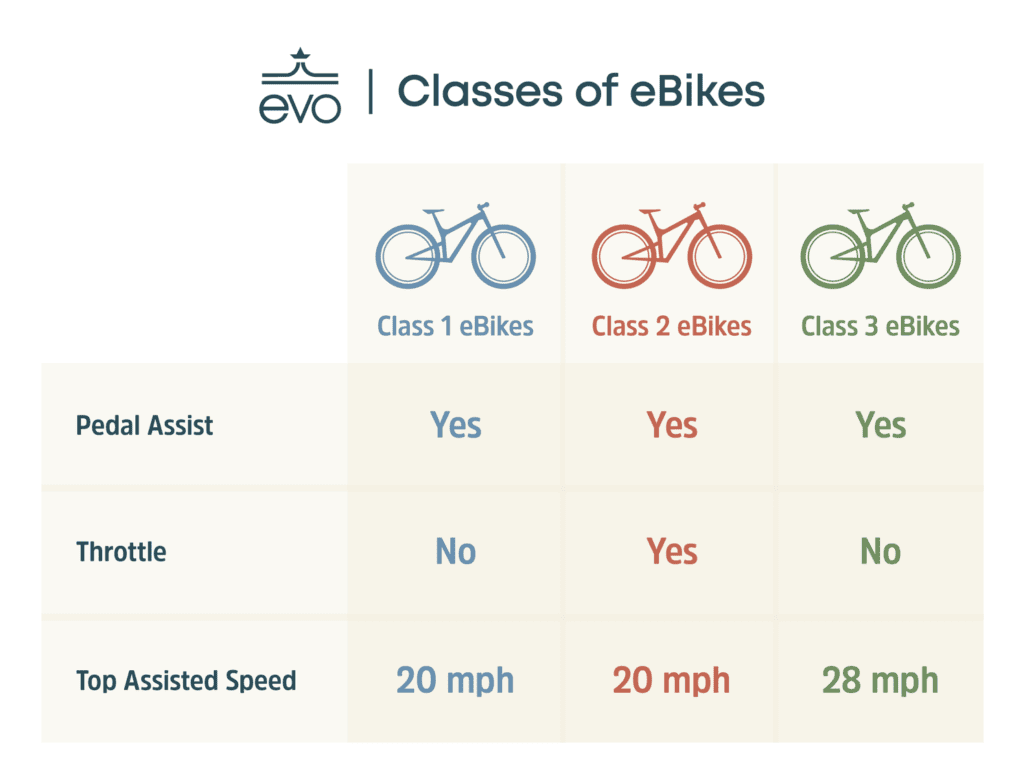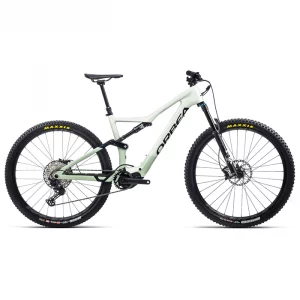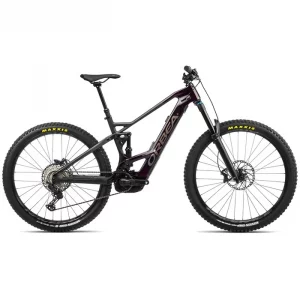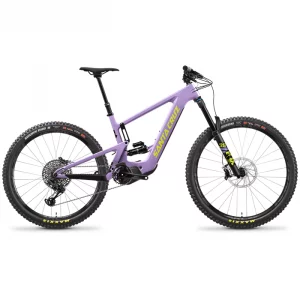|
Getting your Trinity Audio player ready...
|
ebikes are bikes that use traditional bicycle components but have modified frames or wheels that house electric drive units to assist riders. They cut through winds and flatten hills, helping commuters ditch their cars, they turn casual riders into cyclists, and keep families riding together longer. The latest crop of e-mountain bikes are generating the most excitement for us, being very capable on-trail, allow riders to go on longer rides, and replacing shuttle trucks with e-mountain bikes.
Here’s evo’s guide on how to choose an e-bike or e-mountain bike.
How to Choose an eBike?
Choosing the right ebike or e-mountain bike is a lot like choosing any bike – start with the style and intended use, and work into more specific aspects like components and features. Important aspects to consider when choosing an ebike, more specifically, are class, power, and range. Together, these will steer you in the right direction.
The first thing to consider when choosing an ebike is the type of riding that you will be doing, and therefore the style of bike you’ll need. Will you be running errands around town? A cruiser style ebike with more comfortable geometry and components will be the ticket. Will you e using your e-mountain bike to access trails deep in the backcountry? Now you’ll be looking at trail-shredding machines.
For mountain bikers, you should look at the same aspects of the bike when choosing an e-mountain bike. This means looking at frame geometry, travel and components. Read evo’s guide to choosing a mountain bike for more information.
One you’ve settled on the style of ebike, it’s time to consider the ebike specific features like range class and power. We discussed classes of ebikes above – choose here based on your needs and the rules and regulations in where you’ll be riding.
eBike Power – What does Watts Mean on an eBike?
Watts are a measurement of power, for motors like on an ebike and even for your legs powering a bike. Riding on a flat road, an average person will need to produce about 30-50 watts of power to ride a bike at a slow cruising speed. Up your speed, or add in a hill, and this number grows quickly. Pro cyclists, like those in the Tour de France, can produce up to 400 watts of power. In the US, ebikes are limited to 750W. You will need more power to go faster, and carry larger loads. However, wattage is not the only factor in power – the voltage of the battery and the amperage of the controller also affect the power output. This can be a bit confusing, but it’s important when comparing ebikes.
What are Watt Hours on an eBike? How Long Does an eBike Battery Last?
While wattage describes power, watt-hours describe how much power can be delivered per hour – essential this helps determine the range and how far you can go on your ebike. Typical electric bike batteries range from 250 watt-hours to 1,000 and up. While this gives a general guideline for range, it doesn’t give you the exact mileage. The usage of these watt-hours is what defines the range. This will depend on the type of riding and the level of assist or boost that you’re using, but 15 WH per mile is a good baseline to calculate range.
How Far Can You Go on an eBike?
One of the first questions people ask is, unfortunately, one of the most difficult to answer. The short answer, though: it depends on how much you ask of your drive unit, and how big your battery is. Most commuting ebikes are capable of going 50 miles on a charge, and eMTBs can stay out for a 3-hour ride, depending on terrain and the way the power levels on the battery are utilized. eBikes are getting lighter and smarter every day, so these numbers can only go up.
Orbea Rise M20 E-Mountain Bike 2022
As one of the latest breed of ultra lightweight e-bikes, the Orbea Rise M20 E-Mountain Bike seeks to replace your everyday trail ripper. It’s not much heavier than many traditional bikes, and its smaller battery and motor are more about enhancement than overpowering.
Shop Now!
Orbea Wild FS M20 E-Mountain Bike 2022
Mountain biking is the best because anything can happen and usually does! The trails are constantly in flux, the weather’s a factor, and sometimes you’re just riding better than you ever have. The Orbea Wild FS M20 E-Mountain Bike is made for big days on big trails, but is surprisingly content to just dink around on a quick lunch ride too.
Shop Now!
Santa Cruz Bullit MX CC S E-Mountain Bike 2022
The Santa Cruz Bicycles Bullit MX CC S E-Mountain Bike would be a bargain at twice the price. How could that possibly be, you ask, with those impressively crooked numbers on its price tag? Well, in short, this bike will change your life. It’s a Nomad with its own personal shuttle driver included, except that instead of driving up fire roads you’ll be flying up trail on your way to your favorite DH runs.
Shop Now!
See more e-bikes at evo!
eBike Features & Components
Aside from the batteries and drive units, ebikes are just like traditional bicycles. To deal with the extra weight of the drive units and batteries, they tend to have larger brakes, beefier wheels, and reinforced frames, but for the most part they use the same parts as your normal bike. Most systems allow the rider to choose their level of assist, adding anywhere from 50-350% more power to the wheel. User interfaces can range from very simple buttons to customizable displays mounted on the bars.
eBike Batteries & Drive Units
eBikes have a few different configurations for batteries and motors, also known as drive units. Batteries can be mounted on a rear rack, the downtube, or integrated into the frame. Most e-mountain bikes have internal batteries, since this results in a lower center-of-gravity and the most familiar riding characteristics. Drive units can either be hub-drive or mid-drive. Hub-drive ebikes are more inexpensive to manufacture, and are found on many commuter bikes where their weight doesn’t have as much of an impact on performance. They deliver smooth and quiet power on the flats. eMTBs have more powerful mid-drive units in the bottom bracket area, where their weight has less of a penalty. They’re surprisingly agile and fun.

Source: evo
Classes of eBikes
Not all ebikes are the same – there are three “classes” of ebikes that are defined by the speeds that they can go, and whether or not they have a throttle. These classes apply to all types of ebikes, including e-mountain bikes. It is important to choose the right class of ebike, not only to suit your needs, but to comply with the rules and regulations where you will be riding, as rules can differ for different classes of ebikes. For example, some trails or paths may not allow Class 2 ebikes that have a throttle.
| Class | Drive |
| Class 1 eBikes | Pedal-assist to 20mph, with no throttle |
| Class 2 eBikes | Pedal-assist to 20mph, with a throttle |
| Class 3 eBikes | Pedal-assist to 28mph, with no throttle |
Class 1 eBikes & e-Mountain Bikes
Class 1 ebikes are pedal assisted, meaning that the motor only kicks in while you’re pedalling. The assist tops out at 20mph, meaning the motor will help you up to that speed. These types of ebikes are allowed on most bike paths, and some trails, but always check local rules and regulations.
Class 2 eBikes & e-Mountain Bikes
Similar to Class 1 ebikes, class 2 ebikes are pedal assisted up to 20mph, however, they have one major difference – class 2 ebikes also have a throttle. The throttle on these types of ebikes can vary between buttons or twist-grips. Regardless of design, this means that class 2 ebikes can give you power even without pedaling. Class 2 ebikes are more restricted in their usage than class 1 ebikes because of the presence of the throttle.
Class 3 eBikes & e-Mountain Bikes
Class 3 ebikes offer the fastest pedal-assisted speeds, topping off at 28mph. This means you can enjoy the benefit of pedal assist until you reach 28mph. Class 3 ebikes do not have a throttle.
e-Mountain Bikes
Most e-MTBs fall into Class 1, with mid-mounted drive units and internal batteries that give them a low center-of-gravity. They’re anywhere from 15-20 pounds heavier than non-motorized bikes of the same travel, but they’re well-balanced and ride much like their simpler counterparts. Their components tend to be on the beefier side of the spectrum, with parts taken from enduro bikes, where durability is king. They come in all configurations that traditional bikes do, from hardtails to downhill bikes.
Where Can You Ride eBikes?
ebikes and e-mountain bikes are relatively new and growing fast in popularity – this means there are no blanket rules regarding where you can and cannot ride these bikes. Every region and trail area has different rules and regulations regarding ebikes and e-mountain bikes. Before riding your ebike, make sure to check out the local rules and regulations regarding where you can ride an ebike. For mountain bikers, different land managing agencies, like National Forests, BLM, and state agencies, have different rules and regulations, so ride accordingly. Check the map below for routes and rides that are great for ebike riding, or learn more with our guides on where to ride ebikes.
Why Buy an eBike or e-Mountain Bike?
The reasons for buying an ebike or e-mountain bike really are the same reasons for any bike. Sure, they’re great for riders coming back from an injury, for commuters with more hills than minutes on their route, and for getting some help pulling a trailer…but the overarching reason is the same for so many outdoor pursuits: they’re just plain fun. Ebikes obliterate barriers to entry for non-cyclists, and enhance rides for existing ones. They get more people out riding more often, and they’re going to keep us riding for a long long time.
Skyblue Featured Video: Mountain Bike Beginner Skills | First Trail Ride
After you establish a solid foundation practicing basic mountain bike skills individually, it’s time to combine your skills, put them to the test, and hit the trail for your first ride. Go for a comfortable trail ride or build yourself a circuit! Practice shifting, using your dropper post, cornering, and both front and rear wheel lifts. Start at a slower speed where you feel extra confident, then slowly step it up. When you’re first getting started there is going to be a bit of conscious thought involved. Eventually, this is going to become muscle memory which is the goal. When you’re initially out riding, try to overuse all the items on your mountain bike: your shifter, dropper post, etc. Just remember that practice is going to allow you to use all your bike skills and controls subconsciously. Lastly, we’re out here to have fun so just remember being able to laugh at yourself is a good thing!
Popular Articldes:
Evo’s Buyer’s Guide To Choosing A Mountain Bike
Aventon eBike Brand Now Available at Best Buy
Aventon Bikes: An eBike For Everyone













